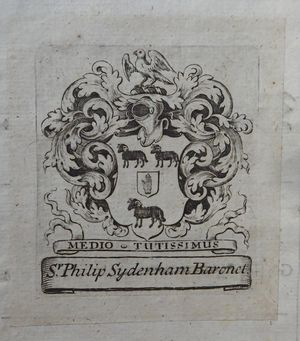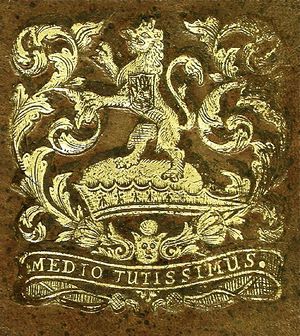Difference between revisions of "Philip Sydenham ca.1676-1739"
| Line 26: | Line 26: | ||
[[Category:Bookplates and Labels]] | [[Category:Bookplates and Labels]] | ||
[[Category:Members of Parliament]] | [[Category:Members of Parliament]] | ||
| + | [[Category:Books Sold at Auction]] | ||
| + | [[Category:Books Sold at Retail Sale]] | ||
[[Category:All Owners]] | [[Category:All Owners]] | ||
Revision as of 00:53, 19 December 2020
Sir Philip SYDENHAM, 3rd bart ca.1676-1739
Biographical Note
Son of Sir John Sydenham, 2nd bart, of Brympton, Somerset, from whom he inherited the title and family estates in 1696. MA St Catherine's College, Cambridge 1696. MP for Ilchester 1701, for Somerset 1701-05; he was elected a Fellow of the Royal Society in 1700. Profligacy and neglect of his estates led him into debt, and he had to sell both his Yorkshire estate at Hackness Abbey ca.1720, and shortly afterwards his main seat at Brympton to his cousin, who allowed him to continue to live there. By the time of his death, however, he was "living in mean circumstances", according to his long-term acquaintance Thomas Hearne, and had long been "an unhappy man". He was unmarried and the baronetcy became extinct after his death.
Books
Sydenham was a keen scholar and bibliophile, and he accumulated a large library, though we have no record of its size or contents. The History of Parliament, citing Hearne, suggests that he had sold at least some of his library before he died, but 3 separate sales of his library, by a mixture of auction and fixed price sale, were advertised after his death (25.3.1740; 3.3.1741; 30.4.1743). No catalogues survive but the first was advertised as "the large and valuable library ... [of which] many of the books are richly bound".
Characteristic Markings
Brian North Lee noted of Sydenham that "no Englishman until Victorian times used as many bookplates", and 11 different plates, known in multiple variant states, were commissioned by him between 1699 and 1738, using a range of designs according to the fashions of the time. He also used two different armorial binding stamps. His books are commonly marked in one or both ways, but not usually inscribed by him.
Sources
- British Armorial Bindings.
- History of Parliament.
- Alston, R. C., Inventory of sale catalogues ... 1676-1800, St Philip, 2010.
- Gambier Howe, E. R. J. Franks bequest: catalogue of British and American book plates bequeathed to the ... British Museum. London, 1903.
- Lee, B. N., Bookpile bookplates, London, 1992, no.142.
- Lee, B. N., British bookplates, Newton Abbot, 1979, no.49.

